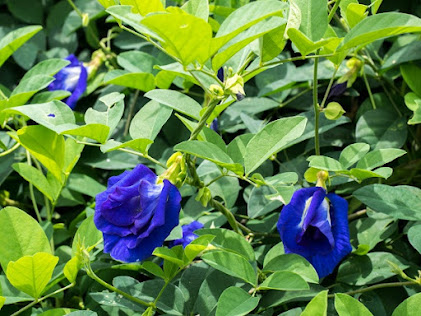 |
| Blueternate Flower |
I was praying to God to guide me on what to do with the money someone had lent me to start up a small business. I was browsing through the internet to search for some stuff to buy and sell afterward. Suddenly, I remembered a post about a blue flower with lots of health benefits, luckily I was able to remember its name and checked if it was available on Shopee, and thank God it was. I ordered a few seeds to start up and hoping they will germinate soon.
I have friends and loved ones who are suffering from cancer and mental illness, the expenses on medication are so frustrating, I was thinking about how can I find or offer some cheap alternatives. I’ve been a fan of alternative medicines and I believe that these plants are going to help some of my friends without spending too much amount just to get cured or alleviate their conditions.
"Clitoria ternatea, commonly known as Asian pigeonwings,[1] bluebellvine, blue pea, butterfly pea, cordofan pea and Darwin pea,[2]is a plant species belonging to the family Fabaceae."In India, it is revered as a holy flower, used in daily puja rituals. It is called "Shanku poolu / Shanku hoova" as it resembles a "Conch shell". In West Bengal, it is known as অপরাজিতা (Aparajita).The flowers of this vine were imagined to have the shape of human female genitals, hence the Latin name of the genus "Clitoria", from "clitoris". In Southeast Asia, the flower is used as a natural food colouring to colour glutinous rice. In Kelantan, east part of Malaysia, by adding a few buds of this flower in a pot while cooking white rice will add bluish tint on the rice which is served with other side dishes and such meal is called nasi kerabu. In Burmese and Thai cuisines, the flowers are also dipped in batter and fried.Butterfly pea flower tea is made from the ternatea flowers and dried lemongrass and changes color depending on what is added to the liquid, with lemon juice turning it purple.[3]In Thailand and Vietnam, this butterfly blue pea flower tea is commonly mixed with honey and lemon to increase acidity and turn the beverage a pink-purple color, to produce for a drink usually served after dinner, or as a refreshment at hotels and spas.[4] The drink is a typical local drink like chamomile tea is in other parts of the world.[4] The tea is found in both hot and cold varieties [5]The flowers have more recently been used a in a color-changing gin. Blue in the bottle, it turns pink when mixed with a carbonatedmixer such as tonic water due to the change in pH.[6] As organic colours are not permanent, this type of gin is recommended to be stored in a dark place to maintain the effect.[7] " Source: Wikipedia
- Improve eyesight
- Improve hair growth
- Improve skin
- Aphrodisiac
- Antioxidant
- Nootropic
- Diuretic
- Analgesic
- Anxiolytic
- Anti-inflammatory
- Anti-Asthmatic
- Anti-anxiety and depression
- Anti-diabetic
- Anti-HIV
- Anti-cancer and anti-tumor
- Anti-microbial
- Anti-convulsant
- Anti-pyretic
credits: http://bit.ly/343nSZ0

Comments
Post a Comment